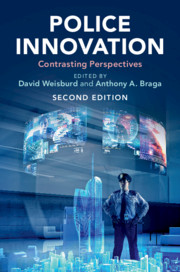Book contents
- Police Innovation
- Police Innovation
- Copyright page
- Contents
- Figures
- Tables
- Notes on Contributors
- Introduction
- Part I Community Policing
- Part II Procedural Justice Policing
- Part III Broken Windows Policing
- Part IV Problem–Oriented Policing
- Part V Pulling Levers (Focused Deterrence) Policing
- Part VI Third–Party Policing
- Part VII Hot Spots Policing
- Part VIII Predictive Policing
- 15 Advocate
- 16 Critic
- Part IX CompStat
- Part X Evidence-Based/ Risk-Focused Policing
- Part XI Technology Policing
- Index
- References
15 - Advocate
Predictive Policing
from Part VIII - Predictive Policing
Published online by Cambridge University Press: 09 August 2019
- Police Innovation
- Police Innovation
- Copyright page
- Contents
- Figures
- Tables
- Notes on Contributors
- Introduction
- Part I Community Policing
- Part II Procedural Justice Policing
- Part III Broken Windows Policing
- Part IV Problem–Oriented Policing
- Part V Pulling Levers (Focused Deterrence) Policing
- Part VI Third–Party Policing
- Part VII Hot Spots Policing
- Part VIII Predictive Policing
- 15 Advocate
- 16 Critic
- Part IX CompStat
- Part X Evidence-Based/ Risk-Focused Policing
- Part XI Technology Policing
- Index
- References
Summary
At the First Predictive Policing Symposium held in Los Angeles in 2009, Assistant Attorney General Laurie Robinson noted, “Law enforcement leaders are using predictive techniques in a variety of forms, but we don’t necessarily have a handle on all of them.” Predictive policing is starting to demonstrate modest positive results; however it is still a nascent field where the dimensions of predictive policing are still not clear. It comprises multiple elements and often means different things to different people.
- Type
- Chapter
- Information
- Police InnovationContrasting Perspectives, pp. 347 - 365Publisher: Cambridge University PressPrint publication year: 2019
References
- 3
- Cited by

